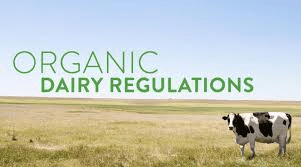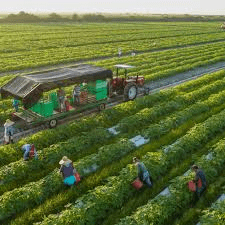Organic farming regulations are guidelines and standards set to ensure that agricultural products labeled as “organic” are produced through specific practices that protect environmental health, animal welfare, and consumer safety. These regulations vary by country but share common principles and requirements.
In the United States, the USDA Organic program regulates organic farming. Under the National Organic Program (NOP), farms and processing facilities must adhere to rigorous standards to receive certification. Key requirements include the use of organic seeds and livestock feed, the prohibition of synthetic pesticides and fertilizers, and the avoidance of GMOs.
Soil fertility must be managed through natural methods like composting and crop rotation. Additionally, farms must maintain detailed records and undergo annual inspections to verify compliance.
In the European Union, organic farming is regulated by the EU Organic Regulation (EC) No 834/2007 and its subsequent amendments. This regulation outlines the standards for organic production, including restrictions on the use of synthetic chemicals, GMOs, and specific guidelines for soil management, animal welfare, and labeling. The EU also has an inspection and certification system to ensure that farms and processors adhere to these standards.
In Canada, organic farming is governed by the Canada Organic Standards, which are managed by the Canadian Food Inspection Agency (CFIA). These standards cover various aspects of organic production, including soil management, pest control, and animal care. Organic products must be certified by an accredited certification body, and farms are subject to regular inspections to ensure compliance.
In Australia, organic farming regulations are overseen by various certification bodies, including the Australian Certified Organic (ACO) and the National Association for Sustainable Agriculture Australia (NASAA). The Australian Organic Standard outlines requirements for organic farming practices, including the prohibition of synthetic chemicals, GMOs, and specific practices for soil management and animal welfare.
Certification is a critical component of organic farming regulations. To label products as organic, farmers and processors must obtain certification from an accredited body. The certification process involves detailed record-keeping, annual inspections, and adherence to specific standards. Certification ensures that consumers can trust the authenticity of organic products and that producers are following approved practices.
Organic farming regulations also emphasize transparency and consumer protection. Organic labels must accurately reflect the product’s certification status and comply with specific labeling requirements, such as the use of the organic seal and information about the certifying body. This transparency helps consumers make informed choices and supports the integrity of the organic market.
Overall, organic farming regulations aim to promote environmentally sustainable and socially responsible agricultural practices. By setting clear standards and requiring certification, these regulations help ensure that organic products are produced in a way that supports soil health, biodiversity, animal welfare, and consumer safety.
Key Components of Organic Farming Regulations

1. Certification Standards: Organic certification requires farms to adhere to specific practices and procedures. Certification bodies inspect and verify compliance with organic standards before granting certification.
2. Soil Management: Organic regulations mandate the use of natural soil amendments like compost and prohibit synthetic fertilizers. Practices like crop rotation and green manuring are encouraged to maintain soil health.
3. Pest and Disease Control: Organic methods must avoid synthetic pesticides and herbicides. Instead, organic regulations promote biological control, mechanical methods, and natural pesticides.
4. Seed and Plant Materials: Organic standards require the use of organic seeds and planting materials. If organic seeds are unavailable, non-organic seeds may be used only under certain conditions.
5. Animal Welfare: Livestock must be raised in humane conditions with access to outdoor spaces and organic feed. Regulations ensure that animals are not subjected to synthetic growth hormones or antibiotics.
6. Record Keeping: Farmers must maintain detailed records of all practices, inputs, and operations to ensure transparency and compliance with organic standards.
7. Labeling and Marketing: Organic products must be labeled according to regulatory standards, including the use of certified organic seals. Marketing claims must accurately reflect the organic status of the product.
8. Input Restrictions: Organic farming regulations prohibit the use of synthetic chemicals, GMOs, and non-organic fertilizers. Only approved substances and practices are allowed.
9. Inspection and Compliance: Organic farms undergo regular inspections by certification bodies to ensure adherence to regulations. Non-compliance can result in suspension or revocation of organic certification.
10. Import and Export Regulations: Organic products must meet the importing country’s organic standards. Certification bodies ensure that imported and exported organic goods comply with both domestic and international regulations.
Organic Farming Regulatory Bodies and their Roles
1. United States Department of Agriculture (USDA): In the United States, the USDA oversees organic farming through the National Organic Program (NOP). The NOP sets standards for organic agriculture, accredits certifying agents, and ensures compliance with organic regulations. The USDA Organic Seal on products indicates adherence to these standards.
2. European Union (EU) Regulations: The European Commission regulates organic farming in Europe through regulations such as EC No 834/2007 and EC No 889/2008. These regulations cover organic crop production, animal husbandry, and food processing, with the EU Organic Logo signifying compliance.
3. International Federation of Organic Agriculture Movements (IFOAM): IFOAM provides global guidelines for organic farming, influencing national and regional standards. Its principles of health, ecology, fairness, and care guide organic practices worldwide, although IFOAM itself does not certify farms.
4. Local and Regional Bodies: Various countries have their own regulatory bodies for organic farming. Canada follows the Canadian Organic Standards, Japan adheres to the Japanese Agricultural Standards (JAS), and other nations have their respective organizations overseeing organic practices.
5. National Agricultural Seed Council (NASC): The NASC in Nigeria is responsible for the regulation and certification of seeds, including organic seeds. They ensure that seeds meet the required quality standards and are free from genetically modified organisms (GMOs).
6. Federal Ministry of Agriculture and Rural Development (FMARD): FMARD oversees agricultural practices in Nigeria, including organic farming. It develops policies and guidelines for organic agriculture and supports the adoption of sustainable farming practices.
7. Nigeria Organic Agriculture Network (NOAN): NOAN is a non-governmental organization that promotes organic farming practices in Nigeria. It works on advocacy, education, and certification of organic farms, and provides guidance on compliance with organic standards.
8. Standards Organization of Nigeria (SON): SON is involved in the development and enforcement of standards for various products, including organic agricultural products. They help in setting standards for organic labeling and certification to ensure product integrity.
Standards for Organic Crop Production
1. Soil Management: Organic regulations emphasize maintaining soil health through practices like crop rotation, cover cropping, and using organic fertilizers such as compost and manure. Synthetic fertilizers and soil conditioners are prohibited.
2. Pest and Disease Control: Organic standards mandate natural pest and disease management methods. This includes biological control, mechanical methods, and cultural practices. The use of synthetic pesticides and herbicides is generally prohibited, with limited exceptions for specific substances.
3. Seed and Plant Material: Organic farming regulations require the use of organic seeds and planting materials whenever possible. GMOs are banned. If organic seeds are unavailable, non-GMO conventional seeds may be used with proper documentation and approval.
4. Water and Environmental Conservation: Standards require efficient water use and conservation. Organic farmers must take measures to protect natural resources, maintain buffer zones, and support biodiversity.
Animal Husbandry in Organic Farming
1. Living Conditions: Regulations ensure animals have adequate space, access to outdoor areas, and facilities that support natural behaviors. Overcrowding is prohibited to maintain animal welfare.
2. Feed and Nutrition: Animals must be fed organic feed, free from GMOs, synthetic additives, and animal by-products. Grazing animals should have access to organic pasture. Growth hormones and antibiotics are prohibited, except in specific cases where alternative treatments are not effective.
3. Health and Veterinary Care: Organic regulations emphasize preventive health care and natural remedies. Synthetic medications are only allowed when necessary, and their use must be documented.
4. Breeding and Reproduction: Natural breeding methods are promoted. Artificial insemination is allowed, but practices like cloning and genetic engineering are prohibited.
Allowed and Prohibited Substances
1. Soil Amendments and Fertilizers: Organic regulations permit natural fertilizers such as compost, manure, and rock minerals. Synthetic fertilizers, sewage sludge, and urea are prohibited.
2. Pest Control Products: Approved natural pest control substances include neem oil, diatomaceous earth, and biological agents like Bacillus thuringiensis (Bt). Synthetic pesticides and herbicides are generally prohibited, with some exceptions.
3. Animal Health Products: Natural remedies and treatments are allowed. Synthetic antibiotics, hormones, and growth promoters are prohibited, except under specific conditions for animal welfare.
4. Processing Aids and Additives: In organic food processing, only a limited number of natural additives and processing aids are allowed. Artificial colors, flavors, and preservatives are banned. Irradiation and genetic modification are prohibited.
Organic farming regulations ensure the integrity and sustainability of organic agriculture by setting standards for crop production, animal husbandry, and handling. Regulatory bodies at various levels, including national organizations like Nigeria’s NASC, FMARD, NOAN, and SON, play crucial roles in enforcing these standards. Adherence to these regulations supports environmental conservation, animal welfare, and the production of high-quality organic products.
Read Also: Nutrient Requirement of Pigs and Swine Feeding Methods
Labeling and Marketing Requirements

1. Clear Labeling: Organic products must be clearly labeled to distinguish them from conventional products. Labels should include the organic certification logo of the relevant certifying body (e.g., USDA Organic, EU Organic Logo). The label must also list all organic ingredients and comply with national regulations regarding claims and representations.
2. Certification Information: Labels should provide information about the certifying body and the certification status of the product. This ensures transparency and helps consumers verify the authenticity of organic claims.
3. Marketing Claims: Marketing materials and claims must adhere to regulations regarding organic products. Claims such as “organic,” “100% organic,” or “made with organic ingredients” must be substantiated by certification and specific percentages of organic content.
4. Product Packaging: Organic products must be packaged in a manner that protects their integrity and complies with labeling regulations. Packaging should not include misleading claims or imagery that could confuse consumers about the product’s organic status.
Compliance and Inspection Procedures
1. Certification Process: To become certified organic, farms and facilities must undergo a rigorous certification process. This involves submitting detailed documentation about farming practices, inputs used, and production methods to an accredited certifying body.
2. Inspection Visits: Certifying bodies conduct regular inspections of organic farms and processing facilities to ensure compliance with organic standards. Inspections typically involve reviewing records, checking practices, and sampling products for residue testing.
3. Record-Keeping: Organic farmers and producers must maintain detailed records of all inputs, production processes, and sales. These records are essential for demonstrating compliance during inspections and audits.
4. Compliance Enforcement: Certifying bodies have the authority to enforce compliance by issuing warnings, fines, or revoking certification if regulations are not met. Non-compliance can also result in legal action and damage to the farm’s reputation.
Challenges and Opportunities in Organic Farming Regulations
1. Regulatory Complexity: The complexity of organic regulations can be challenging for farmers, especially new entrants. Navigating different certification standards, documentation requirements, and compliance procedures can be overwhelming.
Opportunity: Enhanced training and support programs can help farmers understand and adhere to regulations. Simplifying the certification process and providing clear guidelines can reduce barriers to entry.
2. Cost of Certification: The costs associated with certification, including application fees, inspection costs, and ongoing compliance expenses, can be significant for small-scale farmers.
Opportunity: Financial support, grants, and subsidies for certification and compliance can help offset these costs. Developing cost-effective certification options for smaller farms can also make organic farming more accessible.
3. Market Access and Competition: Gaining access to organic markets can be challenging due to competition and the need to meet stringent labeling and quality standards.
Opportunity: Building strong market networks, participating in organic farming cooperatives, and leveraging direct-to-consumer sales channels can improve market access and reduce competition pressures.
4. Keeping Up with Regulations: Staying updated with evolving regulations and standards can be difficult for farmers and businesses.
Opportunity: Establishing communication channels with certifying bodies, participating in industry associations, and accessing educational resources can help farmers stay informed and adapt to regulatory changes.
Impact of Regulations on Farmers and Consumers
1. On Farmers:
- Positive Impact: Regulations ensure a level playing field, protect organic integrity, and support sustainable practices. Certification can enhance market opportunities and consumer trust.
- Challenges: Compliance costs, complex documentation, and rigorous inspection requirements can be burdensome, particularly for small-scale and new organic farmers.
2. On Consumers:
- Positive Impact: Regulations provide assurance of product authenticity, quality, and adherence to organic principles. Consumers can make informed choices based on clear labeling and certification.
- Challenges: Higher costs of organic products due to certification and production standards can limit affordability for some consumers.
Future Trends in Organic Farming Regulations
1. Harmonization of Standards: Efforts are likely to continue toward harmonizing organic standards globally to facilitate international trade and reduce certification barriers. This will make it easier for farmers to access global markets.
2. Technology Integration: The use of technology, such as blockchain for traceability and digital tools for record-keeping, will improve transparency and efficiency in organic farming and certification processes.
3. Increased Focus on Sustainability: Future regulations will likely place greater emphasis on broader sustainability issues, including climate change mitigation, water conservation, and biodiversity. Organic standards may evolve to address these environmental concerns more comprehensively.
4. Enhanced Consumer Education: As consumer interest in organic products grows, there will be an increased focus on educating consumers about the benefits and importance of organic farming. This will support informed purchasing decisions and promote the growth of the organic market.
5. Support for Small-Scale Farmers: Regulatory frameworks may increasingly support small-scale and new organic farmers through simplified certification processes, financial assistance, and technical support, making it easier for them to enter and thrive in the organic market.
Organic farming regulations play a crucial role in ensuring the integrity, sustainability, and credibility of organic agriculture. While challenges exist, such as regulatory complexity and certification costs, there are significant opportunities for improvement and growth.
The impact of regulations on farmers and consumers is multifaceted, with benefits for product authenticity and market access, alongside challenges related to compliance and cost.
Future trends indicate a move towards more harmonized standards, technology integration, and enhanced sustainability, shaping the evolution of organic farming regulations and supporting the continued growth of the organic sector.
Read Also: Proper Management of Pig Breeding Stocks, Piglets, Weaners, Growing, and Finishing Pigs
Frequently Asked Questions (FAQs) About Organic Farming Regulations

1. What are organic farming regulations?
Organic farming regulations are standards and guidelines that ensure agricultural practices meet specific criteria for organic certification, including restrictions on synthetic chemicals and GMOs.
2. How do I become certified organic?
To become certified organic, a farm must comply with organic standards, undergo an inspection by a certification body, and maintain detailed records of practices and inputs.
3. What are the main requirements for organic certification?
Main requirements include using natural soil amendments, avoiding synthetic pesticides and herbicides, using organic seeds, maintaining animal welfare, and adhering to labeling standards.
4. Are there differences in organic regulations between countries?
Yes, organic regulations can vary by country, but they generally share common principles such as avoiding synthetic chemicals and promoting sustainable practices. Farmers must comply with the regulations of the country in which they operate.
5. How often are organic farms inspected?
Organic farms are typically inspected annually by certification bodies to ensure compliance with organic standards. Inspections may be more frequent if there are concerns or issues.
6. What happens if an organic farm is found to be non-compliant?
If a farm is found to be non-compliant, it may face penalties, suspension, or revocation of its organic certification until issues are resolved.
7. Can organic farms use non-organic seeds?
Organic farms are generally required to use organic seeds. However, non-organic seeds may be used if organic seeds are not available, subject to certain conditions.
8. How do organic regulations impact animal welfare?
Organic regulations require livestock to have access to outdoor spaces, receive organic feed, and avoid synthetic growth hormones and antibiotics, ensuring humane and healthy conditions.
9. What is the role of record keeping in organic farming?
Record keeping is crucial for tracking all practices, inputs, and operations to ensure transparency, verify compliance, and address any issues during inspections.
10. How do organic farming regulations affect international trade?
Organic farming regulations ensure that exported and imported organic products meet both domestic and international standards, facilitating global trade and market access.
Read Also: How to Learn a New Skill






